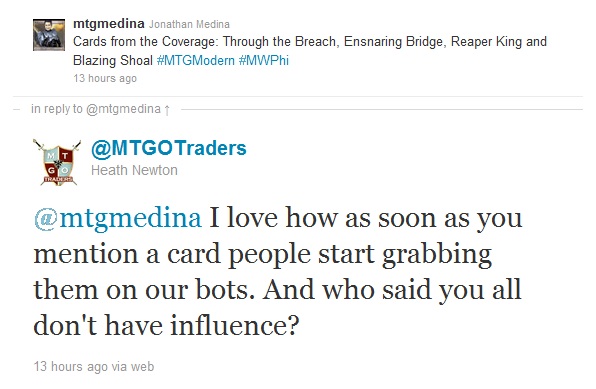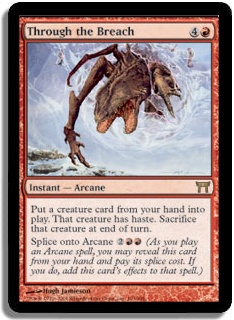I couldn’t focus at work on Friday. The Pro Tour was happening, and there was non-stop Twitter action from 9 am until I left work for the day. The thing that’s so exciting about this Pro Tour is that we get the first real look at the Modern format. Until now all we’ve had to piece the format together is the Magic Online (MTGO) Dailies and a handful of articles. The problem with all of this information being right before a Pro Tour is that you have to take everything with a grain of salt. It’s natural to expect that the pros are not going to share the depth of their tech with the world, and to be fair, they may not even know what that is until the week (or night) before the big show.
The big question for Magic Finance junkies is “what’s the buy?” I see a lot of people rushing to buy everything that gets tweeted or talked about.

It feels like a lot of people are caught up in misplaced hopes of catching a free roll on a junk rare. I’ve written about this before but nine times out of ten, human nature is going to win over my good advice. It’s the same reason why casinos are still and business, even though the house always wins. People want to believe that they’ll get lucky because luck means that you don’t have to work and you don’t have to be good. The reason that I bring this up is because I get a steady stream of questions like this:
Should I buy Through the Breach?
Is Blazing Shoal a good pick-up on MTGO?
What these questions reveal is a distinct lack of understanding for how the market works. There are two forces at work here. The first is what I would call the market inertia; this is defined by the community. I’ll explain it in more detail below. The second is the role of a card; this affects the price of a card. Here’s a thought exercise, why is Gaddock Teeg a $5 card and Vendilion Clique a $35 dollar card? Before we get there, let’s talk about market inertia and what it means.
Market Inertia
The best way for me to illustrate this point is to talk about what happened when Modern was first announced. People lost their collective minds. Even better speculators opened their wallets and poured their cash out all over the floor. Let’s be honest here, no one knew what the hell they were doing (except me of course; oh and Sam Stoddard). There wasn’t even a format yet, and people were buying up cards from past Extended season. I’m not saying that there wasn’t money to be made; you could buy the latest spec (cards that are being speculated on) and then ride the waves to riches. A lot of people did that, but the key thing to realize here is that until Magic Online started holding tournaments, no one had any real data, so people were buying everything.
Once Modern came to MTGO, the feeding frenzy started to slow down. People wanted to see what decks were grinding out the wins before laying their money down. Smart investors dumped their spec, as the MTGO queues started firing. This was a great time because people were building decks, and the demand was high. Once the online metagame started to become established, then the demand for fringe cards started to deteriorate. This is when the market inertia started to slow down for all Modern cards. It eventually grinded to a halt last week because everyone was waiting to see what happened with the Pro Tour.
So, what does all this mean and how is it relevant to questions like, “Should I buy Through the Breach?” What this means is that depending on where the market is, it may not be a good time to buy certain cards. The market for Modern cards has been inflating at a fast rate. Anything that could be deemed Modern playable is going to fetch a premium until we have enough data to sift out the good cards from the irrelevant cards.
The same thing happens with presales for a new set. A cool new card gets spoiled. There’s a wave of people who need to own it. Sometimes the card proves itself, and sometimes it doesn’t, but either way the data is the true judge. The best thing that we can do if we want to buy in on a card early is to use past history and parallels to judge its relevance. That’s where the card role comes into play.
Card Role
This is a crazy theory of mine. It’s not well laid out with facts and charts, so what you’re going to get here is my best attempt to describe how I come to conclusions about cards.
To explain this, we have to go somewhere strange; everyone has used a magnification feature on a computer. It might have been to zoom in on a place in Google Maps or to zoom out so that you can see the full layout of the image. Imagine that zooming in is the Market Inertia moving toward inflation and zooming out is the Market Inertia moving toward depression (this is what’s happening with the Legacy market right now). If you snap back to 100%, that represents a market that’s in balance. If a market is in balance, then cards can be measured by the roles that they play in that market.
The word “market” can mean a million different things, but to understand this concept we will define a Market as a format. This means that the roles that cards play are relative to the format that they’re in. I break these roles into four different categories.
Staples ($1-Infi) — These are cards that see play across many different archetypes in a format. Examples of these would be: Thoughtseize, Vendilion Clique, and Tarmogoyf. Staples hold the highest core value over the other categories because they are more desirable.
Engines ($2- $45) — Some would call these archetype staples. These are cards that are needed for certain archetypes to function. Examples of these would be: Vesuva, Life from the Loam, and Stoneforge Mystic. If a certain archetype sees a decline in popularity then engine cards can suffer price wise.
Answers ($3-$8) — These are typically sideboard cards. Examples of these would be: Mindbreak Trap, Gaddock Teeg, and Ethersworn Canonist. These cards never get too high in the pricing structure. I find it strange, but that’s been my experience.
Tricks ($1-$3) — These cards are cards that are not really necessary in a deck, but they do interesting things in some decks. Examples of these are: Through the Breach, Summoning Trap, and Amulet of Vigor. These cards are the lowest of the low when it comes to price. They always fall in the $1- $3 range, and sometimes they get removed from the deck, which hurts their value.
Like I said above, this is just a crazy theory of mine, which means it’s not completely figured out. For example, planeswalkers don’t easily fit in these categories. I think planeswalkers go by their own rules for pricing.
Despite all the holes in this theory, it can still help to figure out where you should be for certain cards. Let’s look at Through the Breach for a second. Since it’s from the “trick” category, we shouldn’t expect the core value to be more than $3, but because the Modern market has inflated prices, Through the Breach’s core price is heavily magnified. They current sell for about $8-$10 on eBay.
When someone asks “Should I buy Through the Breach?” I wonder what they are planning to pay for them. If my theory has any truth to it, then paying $8-$10 on Through the Breach is really risky unless you expect the market to keep moving toward inflation. I would typically take the safe route and not pay any more than $3 on the card. When the dust settles, I’m pretty sure that Through the Breach will be $3 or less, unless it switches roles in a deck.
Another way that you can use my theory is to look at cards that don’t fit in a positive way. For example, Pyromancer Ascension is an engine; this means that according to my theory it has a lot of room to grow pricewise. Maybe it’s a pickup.
Before I get out of here, let’s recap. When deciding whether to buy a card or not, I first ask myself, where is the market at? Is it hostile to buyers? Do I expect the market to continue in its current direction? What role does the card play? What kind of core value can I expect out of the card when the market slows down or becomes balanced?
If you learn to understand the market and use these ideas, then you can really grind out value. For example, the Legacy market is depressing. This is evident in the prices of some of the staples (see, we’re reading markets by looking at card roles). Look at the price of Force of Will ($59.99). Imagine if you waited for the Legacy market to depress a little more and then you bought a bunch of the staples at below the core prices. Once the market inertia starts rolling in the other direction (maybe due to a Legacy Grand Prix), then you will profit.
I hope that these ideas will help you make smart Modern purchases after the Pro Tour. You can expect cards that did not do well to continue their downward spiral and cards that did do well to be in high demand. Wait for this to happen before buy any format sleeper. That’s all this week. Thanks for reading.
Jonathan

